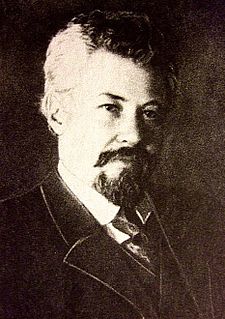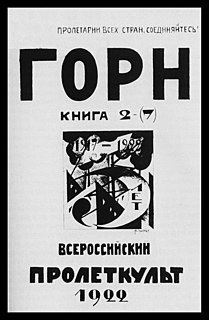
The October Revolution, officially known in Soviet historiography as the Great October Socialist Revolution and commonly referred to as the October Uprising, the October Coup, the Bolshevik Revolution, the Bolshevik Coup or the Red October, was a revolution in Russia led by the Bolshevik Party of Vladimir Lenin that was instrumental in the larger Russian Revolution of 1917. It took place with an armed insurrection in Petrograd on 7 November 1917.

The Russian Revolution was a pair of revolutions in Russia in 1917 which dismantled the Tsarist autocracy and led to the rise of the Soviet Union. The Russian Empire collapsed with the abdication of Emperor Nicholas II and the old regime was replaced by a provisional government during the first revolution of February 1917. Alongside it arose grassroots community assemblies which contended for authority. In the second revolution that October, the Provisional Government was toppled and all power was given to the Soviets.
Soviets were political organizations and governmental bodies, primarily associated with the Russian Revolutions and the history of the Soviet Union, and which gave the name to the latter state.
"Dual Power" was a term first used by communist Bolshevik leader Vladimir Lenin (1870–1924), in the Pravda article titled "The Dual Power". which described a situation in the wake of the February Revolution, the first of two Russian Revolutions in 1917. Two powers coexisted with each other and competed for legitimacy: the Soviets, particularly the Petrograd Soviet, and the continuing official state apparatus of the Provisional Government of democratic socialists.

Elections to the All-Russian Constituent Assembly were held on 25 November 1917, around 2 months after they were originally meant to occur, having been organized as a result of events in the Russian Revolution of 1917. They are generally recognised to be the first free elections in Russian history.

The Military Revolutionary Committee, was the name for military organs created by the Bolsheviks under the soviets in preparation for the October Revolution. The committees were powerful directing bodies of revolt, installing and securing the Soviet power. They executed a role of provisional extraordinary organs of Proletariat power.

Proletkult, a portmanteau of the Russian words "proletarskaya kultura", was an experimental Soviet artistic institution that arose in conjunction with the Russian Revolution of 1917. This organization, a federation of local cultural societies and avant-garde artists, was most prominent in the visual, literary, and dramatic fields. Proletkult aspired to radically modify existing artistic forms by creating a new, revolutionary working-class aesthetic, which drew its inspiration from the construction of modern industrial society in backward, agrarian Russia.

Vladimir Dmitriyevich Bonch-Bruyevich was a Soviet politician, revolutionary, historian, writer and Old Bolshevik. He was Vladimir Lenin's personal secretary. He was a brother of Mikhail Dmitriyevich Bonch-Bruyevich.
Various factions fought over Ukrainian territory after the collapse of the Russian Empire following the Russian Revolution of 1917 and after the First World War ended in 1918, resulting in the collapse of Austria-Hungary, which had ruled Ukrainian Galicia. The crumbling of the empires had a great effect on the Ukrainian nationalist movement, and in a short period of four years a number of Ukrainian governments sprang up. This period was characterized by optimism and by nation-building, as well as by chaos and civil war. Matters stabilized somewhat in 1921 with the territory of modern-day Ukraine divided between Soviet Ukraine and Poland, and with small ethnic-Ukrainian regions belonging to Czechoslovakia and to Romania.
The 7th (extraordinary) Congress of the RSDLP(b), also known as the Extraordinary 7th Congress of the RCP(b), was held between 6–8 March 1918. During this congress the Bolsheviks changed the name of the party to include the word "Communist".

Vladimir Ilyich Ulyanov, better known by the alias Lenin, was a Russian revolutionary, politician, and political theorist. He served as head of government of Soviet Russia from 1917 to 1924 and of the Soviet Union from 1922 to 1924. Under his administration, Russia and then the wider Soviet Union became a one-party communist state governed by the Russian Communist Party. Ideologically a communist, he developed a variant of Marxism known as Leninism; his ideas were posthumously codified as Marxism-Leninism.

Alexander Dmitrievich Tsiurupa was a Soviet state and Party figure.

Golos Truda was a Russian-language anarchist newspaper. Founded by working-class Russian expatriates in New York City in 1911, Golos Truda shifted to Petrograd during the Russian Revolution in 1917, when its editors took advantage of the general amnesty and right of return for political dissidents. There, the paper integrated itself into the anarchist labour movement, pronounced the necessity of a social revolution of and by the workers, and situated itself in opposition to the myriad of other left-wing movements.
Lenin's Plan of "Monumental Propaganda" – is a strategy proposed by Vladimir Lenin of employing visual monumental art as an important means for propagating revolutionary and communist ideas. "The plan" had the significance of creating a large demand for monumental sculpture on a state level, and thus it stands at the origins of the Soviet school of sculpture. The "plan" consisted of two main projects: (1) – decorating buildings and other surfaces "traditionally used for banners and posters" with revolutionary slogans and memorial relief plaques; (2) – vast erection of "temporary, plaster-cast" monuments in honor of great revolutionary leaders.

The left-wing uprisings against the Bolsheviks were a series of rebellions, uprisings, and revolts against the Bolsheviks by oppositional left-wing organizations and groups that started soon after the October Revolution, continued through the years of the Russian Civil War, and lasted into the first years of Bolshevik reign of the Soviet Union. They were led or supported by left-wing groups such as some factions of the Socialist Revolutionary Party, Left Socialist-Revolutionaries, Mensheviks, and anarchists. Generally, the uprisings began in 1918 because of the Bolshevik siege and cooptation of Soviet Democracy, the signing of the Treaty of Brest-Litvosk which many saw as giving huge concessions to the Central Powers, and opposition to Bolshevik socioeconomic policy. The Bolsheviks grew increasingly hard-line during the decisive and brutal years following the October Revolution, and would suppress any socialist opposition whilst also becoming increasingly hostile to inner-party opposition. These rebellions and insurrections occurred mostly during and after the Russian Civil War, until approximately 1924.

Red Guards were paramilitary volunteer formations consisting mainly of factory workers, peasants, cossacks and partially of soldiers and sailors for "protection of the soviet power". Red Guards were a transitional military force of the collapsing Imperial Russian Army and the base formations of Bolsheviks during the October Revolution and the first months of the Russian Civil War. Most of them were formed in the time frame of the Russian Revolution of 1917, and some of the units were reorganized into the Red Army during 1918. The Red Guards formations were organized across most of the former Russian Empire, including territories outside the contemporary Russian Federation such as Finland, Estonia, Ukraine, and others. They were not centralized and were formed by decision of a local political party and local soviet members. By fighting to protect and extend the power of the soviets, they aided the creation of a new state that would give "all power to the soviets": the Soviet Union.

The Russian Provisional Government was a provisional government of Russia established immediately following the abdication of Tsar Nicholas II of the Russian Empire on 2 March [15 March, New Style] 1917. The intention of the provisional government was the organization of elections to the Russian Constituent Assembly and its convention. The provisional government lasted approximately eight months, and ceased to exist when the Bolsheviks gained power after the October Revolution in October [November, N.S.] 1917. According to Harold Whitmore Williams the history of eight months during which Russia was ruled by the Provisional Government was the history of the steady and systematic disorganisation of the army.

The All Russian Constituent Assembly was a constitutional body convened in Russia after the October Revolution of 1917. It met for 13 hours, from 4 p.m. to 5 a.m., 18–19 January [O.S. 5–6 January] 1918, whereupon it was dissolved by the All-Russian Central Executive Committee, making the Third All-Russian Congress of Soviets the new governing body of Russia.

The February Revolution, known in Soviet historiography as the February Bourgeois Democratic Revolution and sometimes as the March Revolution, was the first of two revolutions which took place in Russia in 1917.
Events from the year 1917 in Russia















